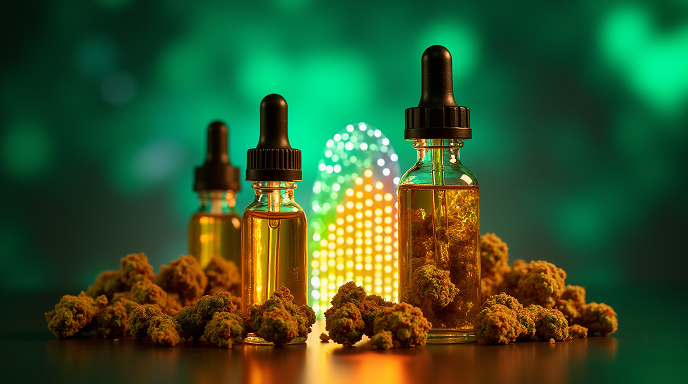
How to Calculate Cannabis Oil Concentrates for Use
Share
Welcome to our blog post on how to calculate cannabis oils for use! Whether you're a seasoned consumer looking for new ways to enjoy your favorite plant or someone who's curious about trying it out for the first time, this article will provide you with all the information you need.
From understanding different types of cannabis oil concentrates to learning how to dose them effectively, we'll walk you through everything step by step. So sit back, relax, and let's dive into the wonderful world of cannabis oil! But first things first, what are oil concentrates?
What are Cannabis Oil Concentrates?
Cannabis oil concentrates are powerful extracts, which are made by extracting the cannabinoids, such as THC and CBD, from the cannabis plant by using solvents like butane or alcohol. The result is a highly potent substance that can be used for various purposes including:
- Pain relief
- Anxiety and depression relief
- Gain more productivity and energy
- Treating insomnia
- And other diseases like Alzheimer’s, Parkinson’s, and cancer.
It’s important to keep in mind that dosing cannabis oil requires careful consideration, as its potency can vary widely depending on factors such as strain type and the extraction method used.
If you’re curious about trying cannabis oil concentrates, start with low doses and gradually increase if needed until you find your optimal dose. But now that we have understood what cannabis concentrate oils are and what they are used for, let’s look at the main types.

The 3 Main Types of Cannabis Oil Concentrates
When it comes to cannabis oil concentrates, there are three main types that you should be aware of. Each type offers a unique experience and potency level, giving users the ability to choose what works best for them. So let’s take a deeper look at each of them:
| Type of Concentrate | Characteristics | Level of Potency |
| Shatter | It is created by extracting cannabinoids from plant material using solvents like butane or CO2, creating a glass-like substance that can shatter into pieces when handled. | Strong |
| Wax | Known as budder or crumble, wax has a softer texture compared to shatter and is created by using a resin press process. | Medium |
| Oil | Cannabis oil concentrates come in various forms, such as oils, distillates, or vapes cartridges and are typically made using CO2 extraction methods, offering precise dosing options. | Medium or low |
Whether you're looking for an intense high with shatter, a manageable buzz with wax, or convenience with cannabis oil cartridges, there's a concentrate out there for everyone's preferences and needs!
But to further understand how concentrates work, let’s take a look at some pros and cons that come with consuming cannabis oil concentrates, so you can make an informed decision if you’re thinking of trying them out.

The Pros and Cons of Consuming Cannabis Oil
Cannabis oil has gained popularity in recent years for its potential health benefits and versatility. However, like any substance, there are pros and cons to consuming cannabis oil. So let’s take a closer look at some pros and cons to consider before trying out concentrates.
| Pros | Cons |
| It can be easily consumed and added to food or beverages. | It can have psychoactive effects on the mind if it contains THC. |
| It is very discreet given it doesn't smell or create as much smoke. | It may lead to nausea or paranoia when consumed in big doses |
| It allows for precise dosing, making it easier to control. | It may lead to serotonin-syndrome when used excessively. |
| It offers multiple therapeutic benefits give it alleviates symptoms for illnesses like chronic pain, anxiety, and insomnia. | There is still limited legislation around these products and could lead to legal problems. |
| It has been proven to have anti-inflammatory properties helping combat certain types of cancer. | Quality control is still lacking making it difficult to find high-quality products in the existing market. |
Consumers considering incorporating cannabis oil into their wellness routine should carefully weigh the pros and cons before making a decision. A good first step is to consult a doctor. If you get the okay, let’s look into the top ways to consume concentrates.

The Top 3 Ways to Consume Cannabis Oil
While there are multiple ways you can consume cannabis oil and it is virtually usable on any food or beverage, there are other ways you could try it out. So let’s take a look at the top three methods of cannabis oil consumption.
- Inhalation, which involves vaporizing the oil and inhaling it with the use of a vape pen or a dab rig, providing quick relief.
- Sublingual administration, which is achieved by placing drops under your tongue and holding them there for a minute or two before swallowing, allowing precise dosing control.
- Edibles, which is done by infusing baked goods, candies, or beverages, allowing for a more discreet and longer-lasting effect.
Remember that everyone's tolerance and preference may vary when it comes to consuming cannabis oil, so finding what works best for you might require some experimentation! But here is a general dosing guide to help you out further.
The 4 Steps to Dose Cannabis Oil
When it comes to using cannabis oil, dosing is a crucial factor that can greatly impact your experience. Finding the right dose is essential for maximizing the benefits and minimizing any potential negative effects. Here are a few steps you can follow to ensure this:
- Start low and go slow, allowing you to gauge how your body reacts and giving you the opportunity to gradually increase your dose if needed.
- Consider your goals which can help guide you in determining the appropriate dosage.
- Consult your dose with an expert such as budtenders at dispensaries or healthcare professionals experienced in cannabinoid therapy.
- Keep track of your dosage which will enable you to make adjustments over time based on personal experience.
Remember, dosage is personal and may vary depending on factors such as weight, metabolism, and individual sensitivity. By starting low and experimenting responsibly, you can discover the ideal dose that suits your needs when using cannabis oil.

Conclusion
Understanding how to calculate cannabis oils for use is essential for anyone looking to incorporate these products into their wellness routine. By knowing the concentration of cannabinoids in your oil, you can determine the appropriate dosage and ensure a safe and enjoyable experience.
It’s worth experimenting with different methods,dosages,and strains until you find what works best for you. With patience, you will discover an effective way to integrate cannabis oils into your wellness journey. So enjoy exploring this versatile plant extract responsibly!
